John Petrucci reveals his almighty live rig and the key to astonishing solos
An exclusive behind-the-scenes look at the Dream Theater guitarist's touring setup

Introduction
We talk to fretmeister John Petrucci about Dream Theater’s most recent album and takes a peek behind the scenes at the live rig fuelling his brand-new signature amp…
We were not only granted an audience with the man himself, but also exclusive backstage access
In January this year, Dream Theater released The Astonishing, a concept album set in a dystopian future where machines called NOMACS have taken on the role of passion-free music suppliers to a feudalised population.
The hero is a character who has been blessed with the gift of music, which helps form the catalyst that fires a revolution. Conceived primarily as a stage show, The Astonishing was overseen and produced by John Petrucci, and we were not only granted an audience with the man himself, but also exclusive backstage access to the second date of the band’s European tour in order to feast our eyes on the guitar rig necessary to take on such a mammoth project.
Don't Miss
Dream Theater's John Petrucci: my top 5 tips for guitarists
John Petrucci on Dream Theater's epic concept album The Astonishing
Dream Theater's John Petrucci: my top 5 not-so-guilty pleasures of all time

Concocting the concept
How did you approach the challenge that this concept presented?
It forced me to pull from everything I know and then some
“As a player, I had to be able to do what was musically relevant for what was happening in the story. That meant pulling everything from aggressive parts to beautiful, sensitive parts; sad playing, pretty playing, comical playing… I ran the gamut - picture watching a cartoon, playing along and scoring it as it’s going. It forced me to pull from everything I know and then some.”
As an insight into your creative life, what would a typical day be like during the writing phase of the project?
“As far as the writing of the story, it was really me sitting down in front of my computer and piece-by-piece diving into it, doing a lot of organising, analysis, developing the characters, coming up with names, coming up with settings, plot… Just a little bit every day as a writer would do, immersing myself into that world.
“Then, once completed, doing very regular revisions, trying to tighten it up, work on the mythology a bit and fix any holes in the story. That was what was involved in actually writing the story part of it.”
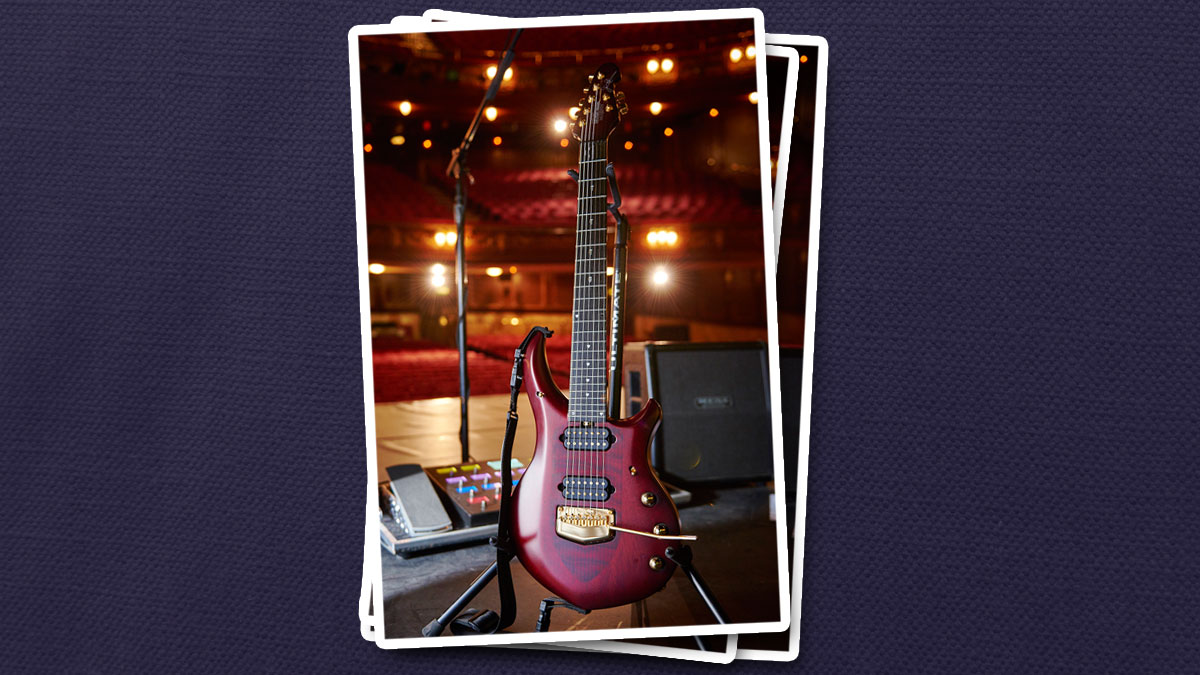
His Majesty
What’s your go-to recording rig these days?
“The guitar that I use is my Majesty Signature Music Man guitar and I used the six- and seven-string Majesty [latter pictured above] throughout the whole album except for one song, The Path That Divides, where I used my Music Man JP15. Other than that, it was all Majesty, and the acoustic was a Taylor 914.
It was designed by Randall Smith and it’s a bona-fide genuine reissue of the Mark IIC+, but modernised, as per my request
“The amp that I use is actually a Signature Mesa/Boogie, something we’ve been developing for a while now. I’m really, really excited about it. With the exception of a limited run of Carlos Santana Mark I amps, this is their first signature amp, so I’m really, really proud. It was designed by Randall Smith and it’s a bona-fide genuine reissue of the Mark IIC+, but modernised, as per my request.
“There are three channels, two graphic EQs, it’s MIDI-capable, it has a built-in CabClone and two lead channels. It’s an unbelievable amp and it’s the only one I used on the album. All the rhythms, all the leads, all the cleans were that one amp.”
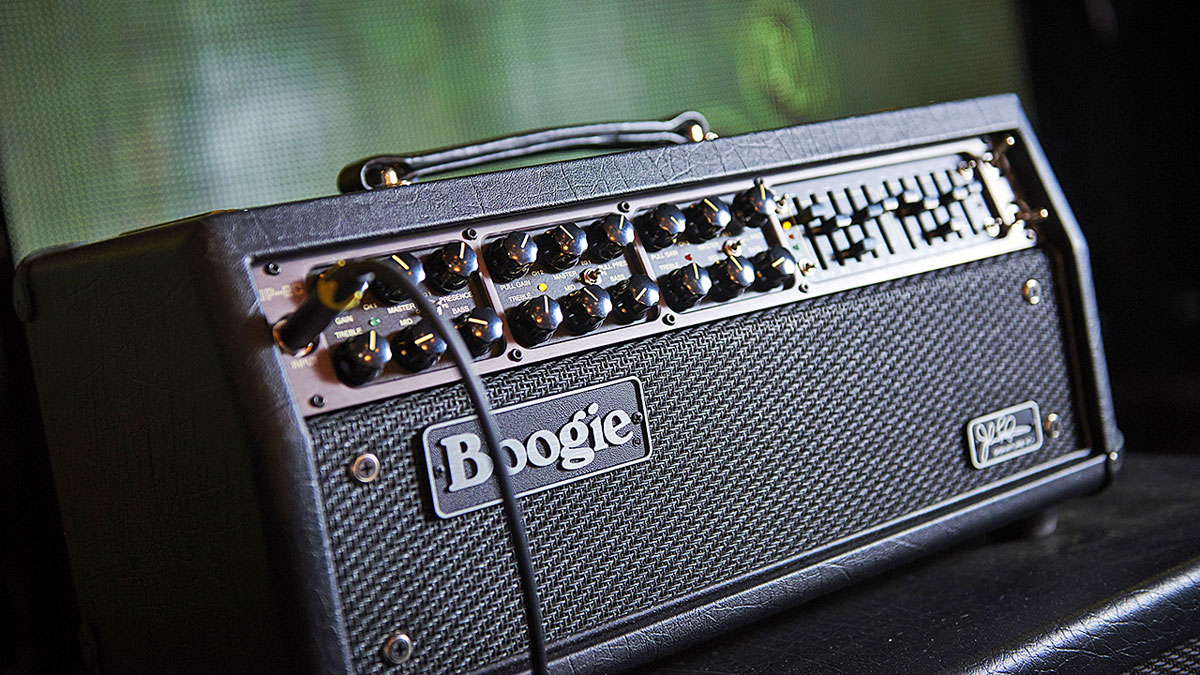
Signature sound
Did you try a few different versions of the amp or did you know what you wanted?
“They got to it really quickly, actually. I think they did three prototypes and that was it. The first one, actually, I started tracking with right away on the song Our New World. I did the solo while we were still writing and demoing the songs and I had that proto, did those solos and ended up keeping them. So they really, really nailed it from the beginning.”
How do you like to set your three-channel amps up with a view to them undertaking several roles in a set?
The rhythm sound is something that I want to be generally aggressive yet tight
“Generally, I go for very, very super-clean; lots of headroom. I want the notes to be shiny but also have some weight, in the way a piano note would sound. It’s clean and as open as possible and it’s a nice sparkly presence and not a lot of middle.
“The rhythm sound is something that I want to be generally aggressive yet tight, so it has a proper amount of gain but to the point that if you play tight low notes, especially on a seven-string detuned guitar, it’s not going to flub out or break up.
“So I generally dial in very little bass on the controls, and the frequencies that control the upper-end harmonics, like the treble and presence, are up to give it that sort of ripping, tight sound.
“I use a general kind of ‘D’ setting on the graphic and in the lead channel, I like to up the gain to make it more liquid and add more mids than I would on the rhythm, so it’s not a scoop. It has more of a vocal sound to it and I cut down the highs a bit, so it’s not shrill when you get up to the higher register of the guitar.”

Melody maker
If you could single out one musical principle that you believe leads to better guitar playing, what would it be?
Guitar players who have a strong sense of melody are always the ones that stand out
“To me, it’s always been a sense of melody. I think it’s very important, because the melody is the place where you can really have a voice and you can really be unique. It’s a magical thing - you can conjure up all kinds of feelings, whether they are new, unique or familiar and recognisable, to evoke some kind of emotion.
“I think guitar players who have a strong sense of melody, a strong melodic focus, are always the ones that stand out. Steve Morse, David Gilmour, Tommy Emmanuel, Joe Satriani - you know, guys like that.”
Which musician has been most influential in shaping your approach to guitar?
“For me, it would be Steve Morse. The moment I heard him play I was not only blown away, but really, really inspired to want to do better, to expand my playing and my writing. Then I got to see him play live and eventually meet him, become friends and play with him on G3.
“He just never ceases to be an inspiration - a positive light as far as sticking with things, having a strong practice ethic, being your creative best, working hard as a musician, pursuing tone, pursuing the craft of guitar building with Music Man… All the things that he does have been really hugely influential to me.”

Sound advice
What steps would you recommend if a player wants to bust themselves out of the cul-de-sacs in their playing?
“Practise outside your comfort zone. Try improvising in keys like Ab - non-typical guitar keys - and that might force you to do things you might not normally gravitate towards because it all seems unfamiliar.
Learn lines and phrases from instruments other than guitar... It forces you to do things you wouldn’t normally do
“Another thing is to learn lines and phrases from instruments other than guitar. If you’re picking things up from piano, saxophone or violin, you’re going to do things more tailored towards those instruments, but not very familiar or comfortable on the guitar. It forces you to do things you wouldn’t normally do.”
If you had five minutes coaching a complete newcomer on how to play a good solo, what would be your advice?
“The first thing is, you need to listen to what you’re soloing over. You need to be conscious of the chords that you’re playing over and also the structure; look at the length of what you’re going to be soloing over. You have a certain amount of time to tell a story - you don’t want a guitar solo to be the point where there’s a lull in the energy. You want it to be as musically relevant to the song as any other part of it.
“So, if you’re aware of the chord progression, if you’re aware of the amount of time you have and whether it’s improvised or prethought out, you have a beginning, middle and end. You have a structure. You’re telling a story within that time, you’re contributing to the music. I think that’s a really good way to focus on practising soloing.”
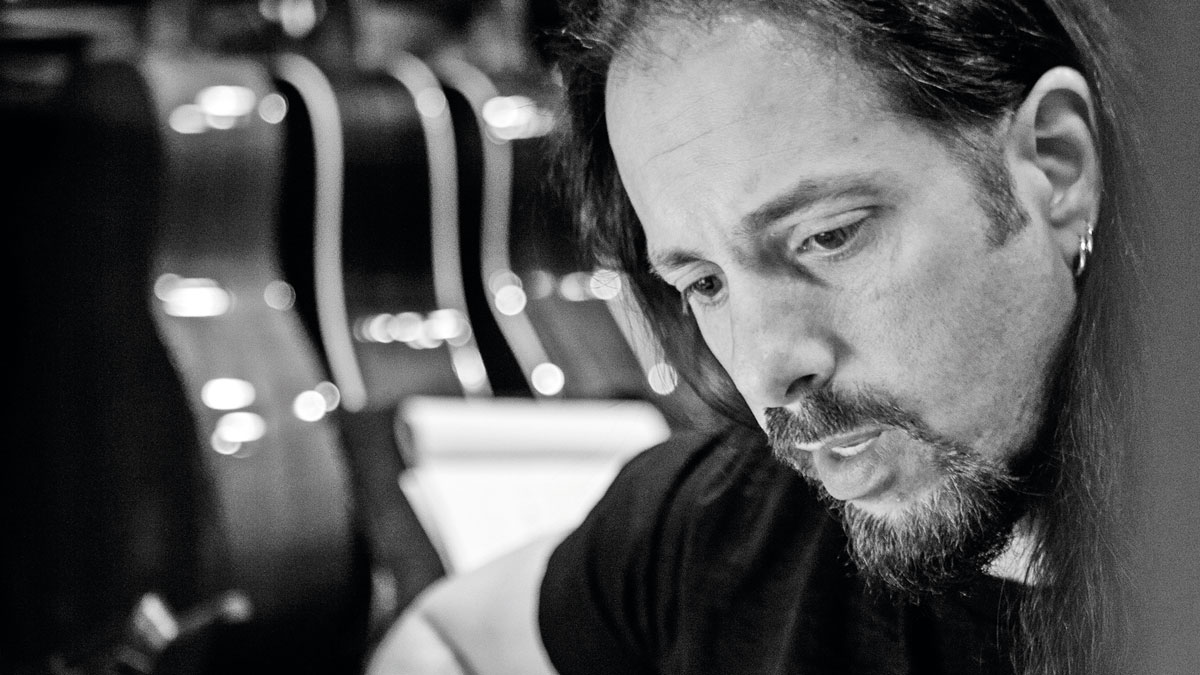
You're the voice...
What aspect of playing guitar gives you most pleasure these days?
“I guess any musical instrument is an expressive instrument, but, for me, it’s a way to have a different type of voice.
It's a way to say some things that I wouldn’t normally say just through language
“You know, to maybe say some things that I wouldn’t normally say just through language. You can kind of pull some things out that are sometimes a lot deeper and more meaningful. So, to me, it’s an extension of expression and it’s an outlet for creativity.
“That’s something I’ve always gravitated towards, whether it’s writing or storytelling or art or music. Having an outlet for expression is really, really important to me, and the guitar helps me find that place.”
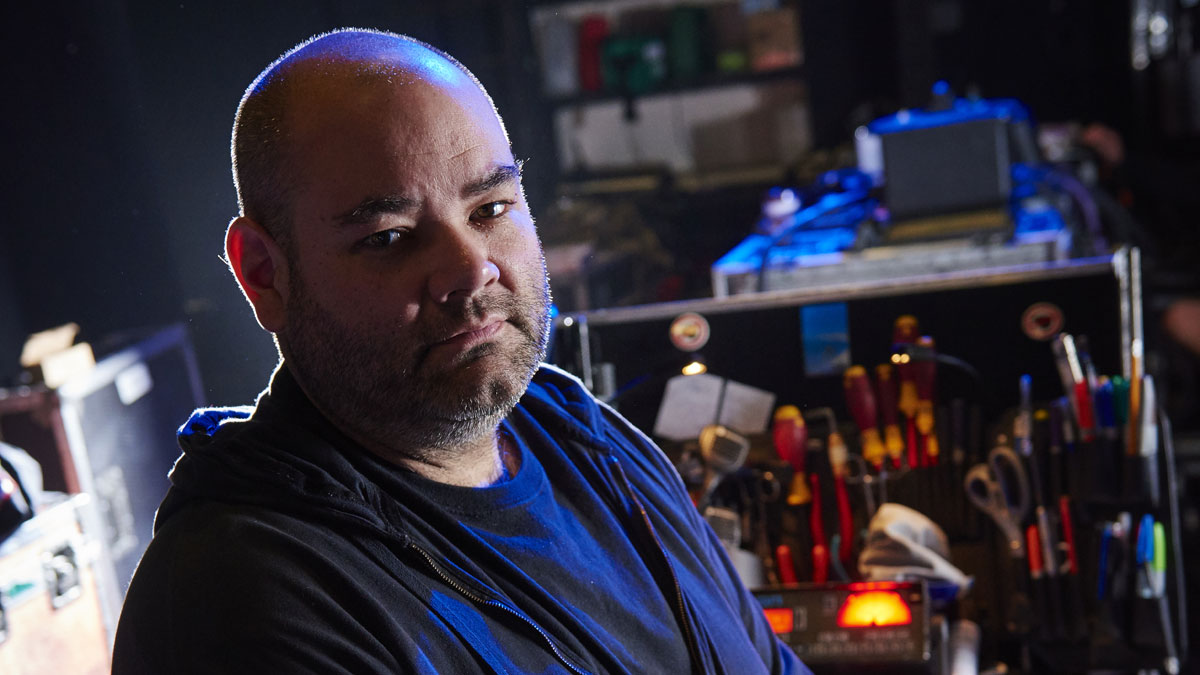
Meet Maddi
After releasing The Astonishing, the next step for the band was to perform the piece live.
We were invited backstage at the London Palladium on the second night of Dream Theater’s European tour for a look at the gear necessary for Petrucci to bring the album to life on stage. Our tour guide is guitar tech and right-hand man, Maddi.
Can you outline the things that you’re called upon to do at a Dream Theater gig?
The goal is, when John walks out on stage, he doesn’t have to think about anything but playing
“The goal is, when John walks out on stage, he doesn’t have to think about anything but playing. For me, that means tuning the guitars, doing guitar changes when they need to be changed, sometimes engaging or disengaging effects, changing banks on the pedalboard to get to a new song, bringing the acoustics on and offstage, changing amp settings… My responsibility at showtime is pretty much anything to do with him being on stage, playing.”
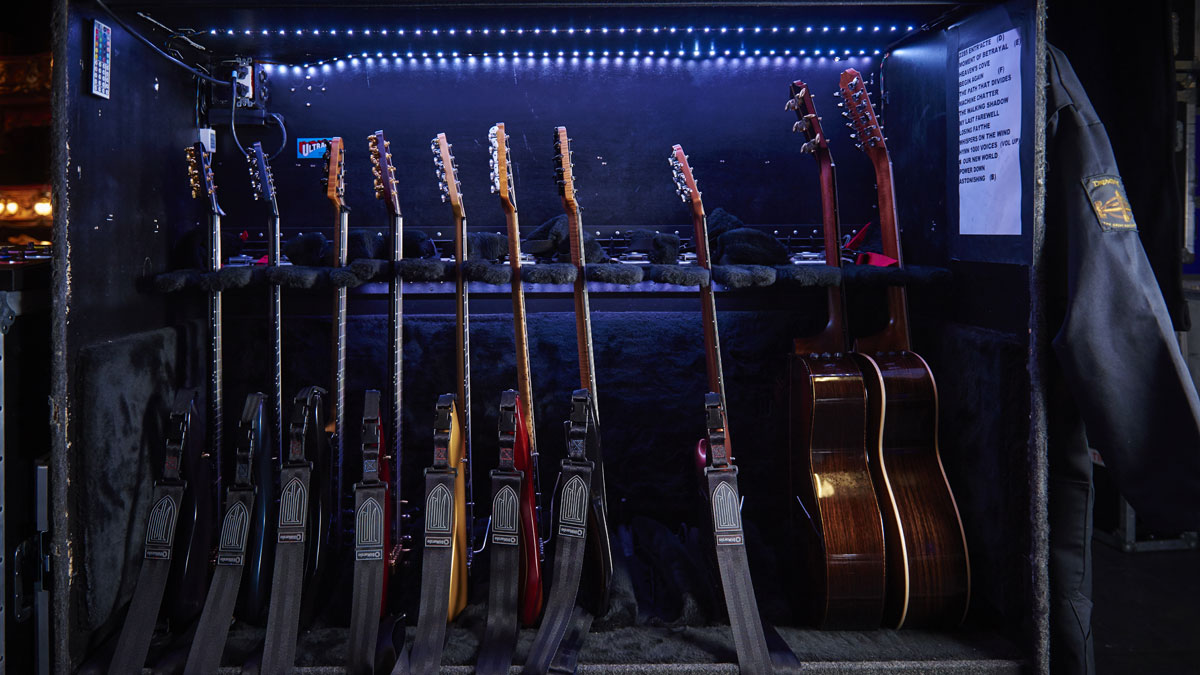
On the rack
There seem to be three guitars in action at present, but a whole rack backstage - will John use the others, or are they spares?
As we move forward and John gets more settled, we’ll start swapping guitars around a little bit more
“Last night was the first show, so as we move forward and John gets more settled, we’ll start swapping guitars around a little bit more. Basically, he plays a standard-tuned six-string, a standard-tuned seven-string and a drop-D guitar for one song. Then he’s got two acoustic guitars that he switches between: a Taylor 12-string for one song and a Taylor six-string for everything else, probably five other songs in the set.”
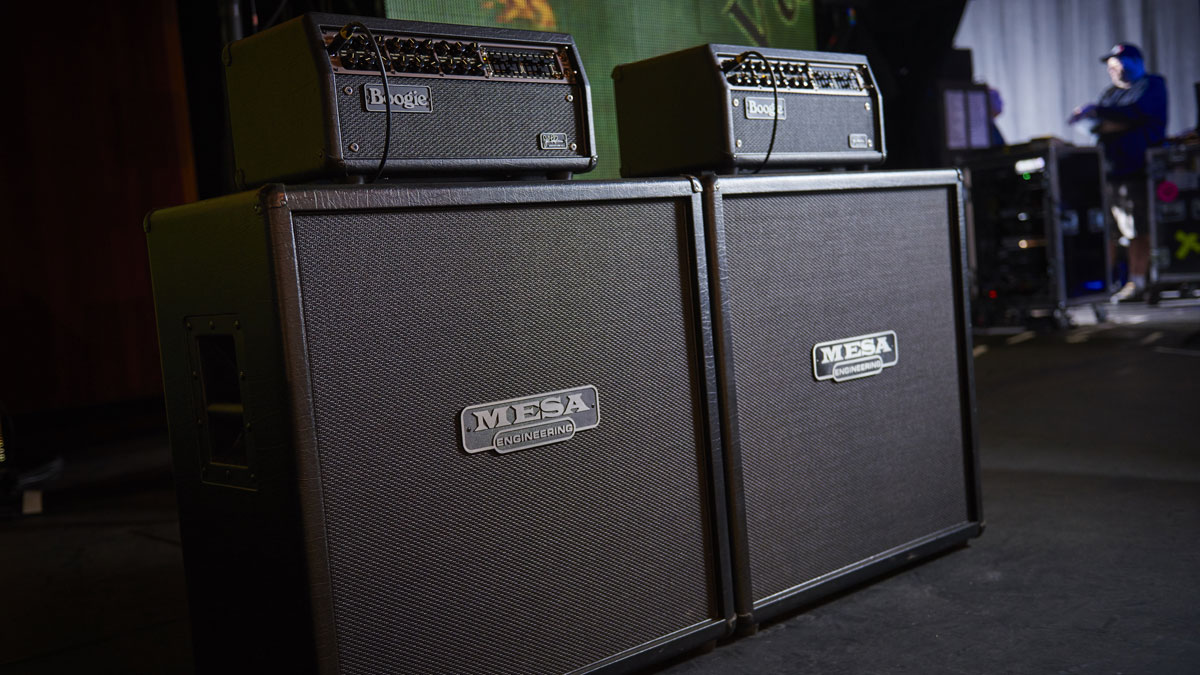
Stray from the signal path
The gear backstage comprises your workbench, where you change strings and generally keep everything in working order. Then there’s Petrucci’s rack, containing a neatly packaged array of amps and effects. It looks a little mind-boggling…
There are two separate signal paths as John’s guitars have two pickup systems, a magnetic and a piezo
“There are two separate signal paths: one’s really easy and one’s kind of easy. John’s guitars have two pickup systems, a magnetic and a piezo. So we run a stereo cable - two separate cables in one - out of the guitar into this Framptone A/B box; it’s just a passive A/B box. The cable then splits into two mono signals out of the A/B box: one is for the magnetic pickups, one is for the piezo acoustic pickups.
“We’ll do the piezo side first, because that’s really easy. Out of the A/B box, we go into a little isolation transformer, which just gets rid of any grounding issues. Out of the transformer into the TC BodyRez pedal, which we just switch to, sounds fantastic. Out of the BodyRez pedal into a Radial DI box and out to the PA and monitors. That’s it - boom - done. All the reverb and compression, if there is any, is done at the consoles, not here.”
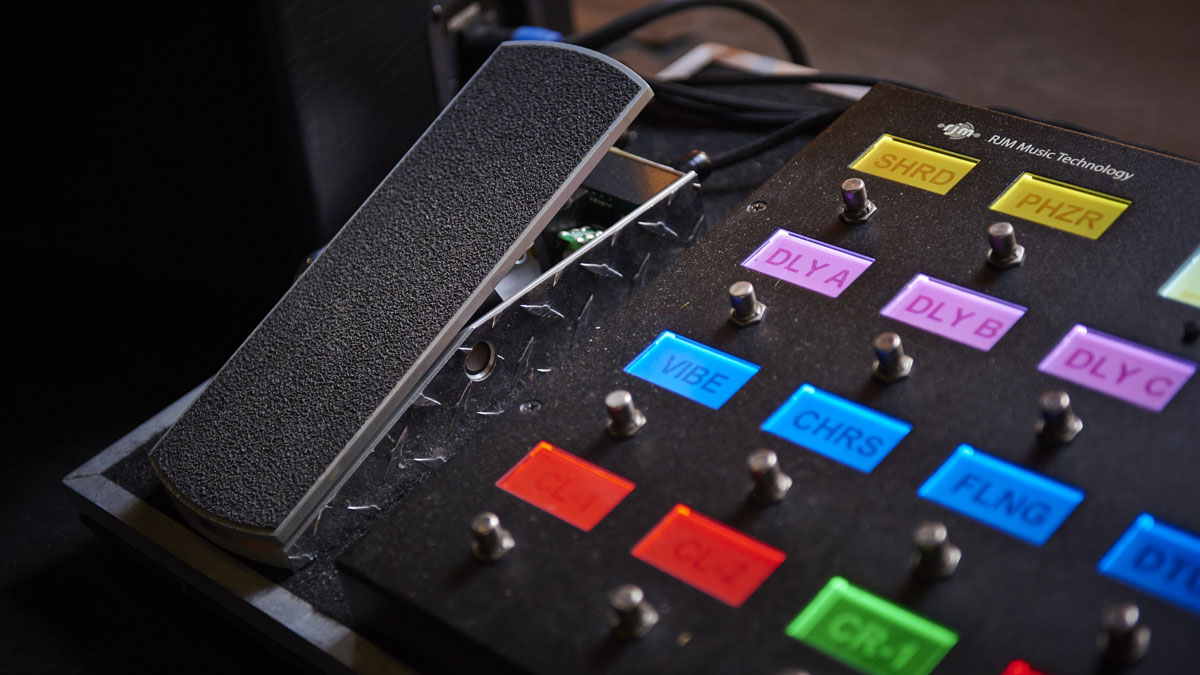
Rack and back
How about the magnetic pickups?
“Signal path two is the magnetic side and this is where it gets a little interesting… Out of the A/B box and into an RJM Tone Saver, which is basically just a buffered splitter. One side feeds the input of the rig, the other side feeds the tuner on the pedalboard, so he has a tuner attached to the guitar at all times without any sort of effects or anything like that.
We have a lot of cabling, so I said to Dunlop, ‘Now that we’ve done the Signature Wah, can you actually put it back in the rack chassis?'
“For the side that comes into the rig, the first thing we hit is the Dunlop Wah System. John has a new Dunlop Signature Wah pedal, which is essentially the Dunlop Rack Wah in a pedal form. We took all of his settings from the rack wah, miniaturised it and stuck it in the actual pedal.
“For touring, I don’t have any audio cables, except for the tuner send, that run out to the pedalboard. If I had to run a wah pedal out there with regular cables, we’re talking 100ft of cabling back and forth, so that’s a lot of cable and signal loss.
“So I said to Dunlop, ‘Now that we’ve done the Signature Wah, can you actually put it back in the rack chassis so I can keep the signal flow in the rack and just have the control pedal out on the pedalboard?’ And they said, ‘Sure, no problem.’ So that’s what they did.”
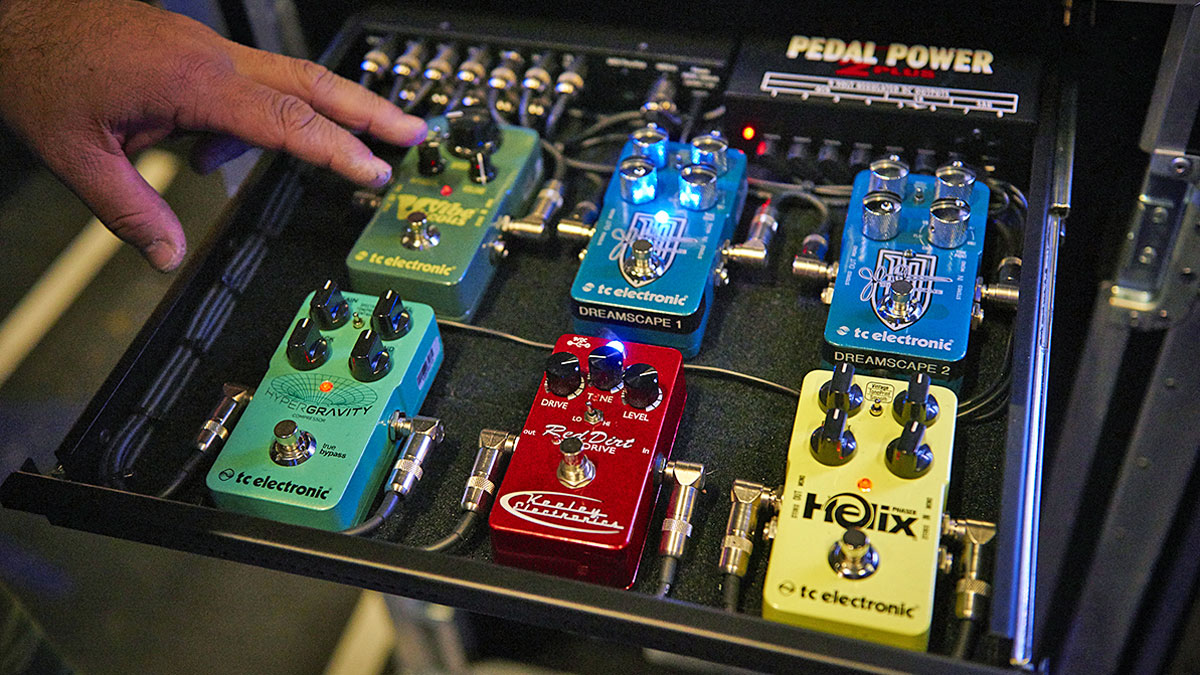
Hidden secrets
At the top of Petrucci’s rack, there’s a hidden drawer containing a few pedals…
“Yes, out of the wah unit, we come up into the pedal drawer. We’ve got an RJM Mini Effects Gizmo Switcher, five true-bypass loops, MIDI controlled. Loop one is the TC HyperGravity Compressor; loop two is the Keeley Red Dirt Overdrive pedal; loop three is the TC Helix Phaser; loop four is the Uni-Vibe pedal.
All the TC pedals, except for the ’Vibe, have John’s TonePrint settings
“Typically, in a five-loop setup, we’ve got three or four pedals that are mainstays and one that’s sort of a ‘let’s find something new and interesting to put in there’. In previous racks, we were using the Boss [DC-2] Dimension C pedal - great, cool modulation-type sound.
“This time around, we said, ‘Why don’t we use a Uni-Vibe?’ So that’s what we did. Loop five is actually two of his TC Signature Dreamscape pedals daisy-chained together like you would on a normal pedalboard and I just switch between them manually. One is set up for that kind of Van Halen jet flanger sound and the other for a more subtle flanger sound.”
Have any effects been customised at all?
“All the TC pedals, except for the ’Vibe, have John’s TonePrint settings. We’ve sat with the guys at TC, programmed the sounds John likes, loaded them in as TonePrints, so the controls are set at 12 o’clock and it’s the sound that John wants. No muss, no fuss.”
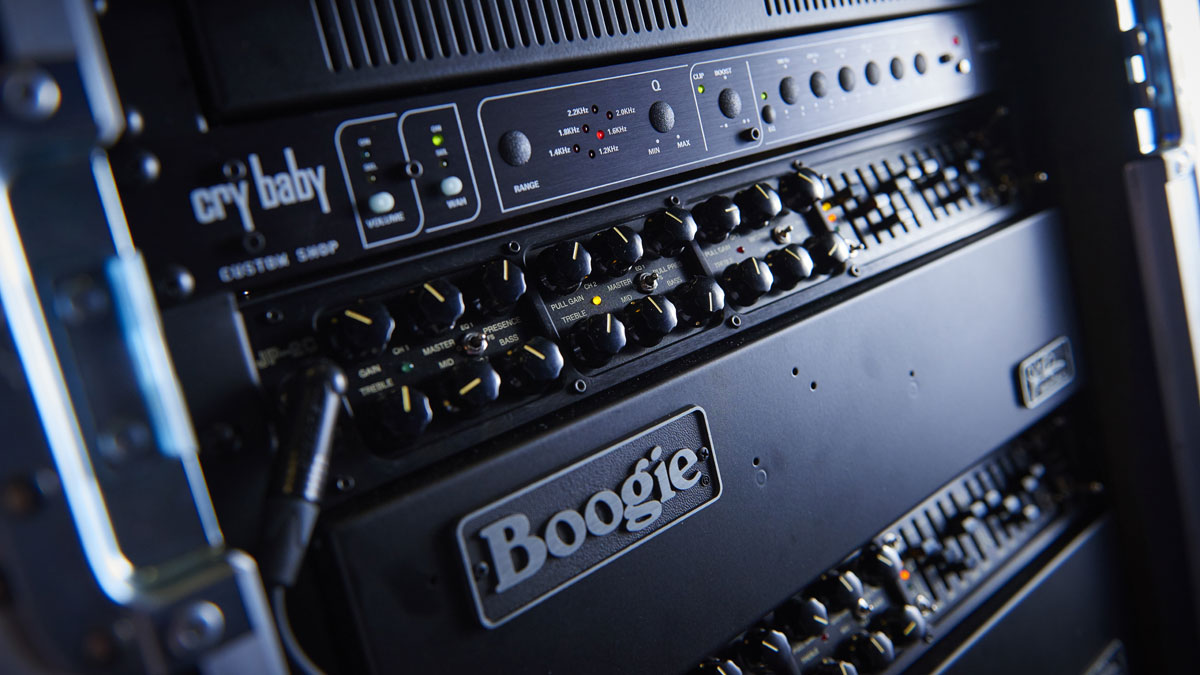
Into the amps
We spy a Voodoo Lab Pedal Power 2 Plus power supply for everything in the drawer…
“Correct, and out of the drawer we come into the Mesa/Boogie JP-2C Signature amplifier. Three-channel amp: clean and then channel two and channel three are virtually identical. Two graphic EQs assignable to any channel, all MIDI controlled.
Everything that’s been designed into this amp has been designed from a performance standpoint
“It’s a very straightforward amplifier: it doesn’t have all the bells and whistles that you may have encountered on other Boogie amps. This is going back to the old IIC+, with some modern upgrades.
“Everything that’s been designed into this amp has been designed from a performance standpoint. The one limitation John always had with the old vintage amps was there was one graphic EQ, so he had to compromise. Essentially, we use channel two for all of his rhythm sounds, channel three is all the lead sounds, EQ1 is for the rhythm, EQ2 is for the lead.”

Fractal fun
What about the amp’s effects loop?
“This is where we get into all the cool delays, chorusing and pitch-shifting and all that. The effects loop goes into the input of a Fractal Axe-Fx II XL+, it’s their latest hardware version.
That’s where all of John’s delays come from, so we have a bunch of different blocks in here
“That’s where all of John’s delays come from, so we have a bunch of different blocks in here, like the harmoniser. He’s not really using it that much, but it’s kind of your standard Eventide Harmoniser - he can do 3rds, 5ths, whatever he wants to.
“There’s an enhance block, there’s a couple of different chorus blocks, there’s another pitch block that’s kind of like a TC 1210-style chorus that he uses for a couple of songs. Stereo outs of the Axe-FX output: One Left comes back to the effects return of the main amplifier, One Right comes to the effects return of the second amplifier, which is just acting as a power amp.
“Both of these amps feed Mesa Rectifier 1x12 cabinets that sit offstage, and they’re mic’d up with a pair of Shure SM57 and Shure KSM313 ribbon mics - that’s the sound for the front of house and monitors.”
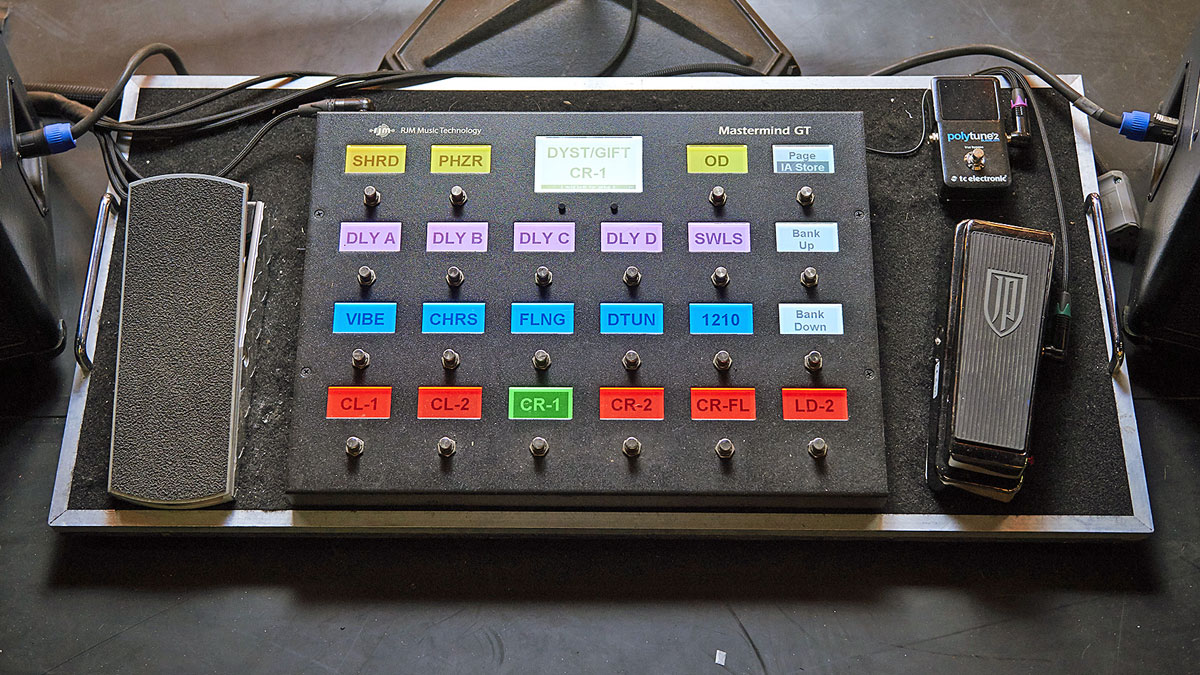
Masterminding it all
And how about output 2?
“Output 2 left and right of the Axe-FX feeds inputs left and right of a Mesa 20/20 Dyna-Watt power amp. That power amp feeds the two Mini Recto 1x12 cabinets that are on stage at the pedalboard, which just act as a little bit of a monitor.
John’s on in-ear monitors for everything, but two 1x12s help him get some feedback and just some feel out there at the pedalboard
“John’s on in-ear monitors for everything, but it helps him get some feedback and just some feel out there at the pedalboard. Everything’s controlled by the RJM Mastermind GT/22, the flagship pedalboard. I think I’ve got five or six banks of presets set up in there, depending on the song.
“We’ve two pedalboards and they’re connected together so he can control things out here; I can jump in and control things offstage. Sometimes, I’ll have to call up an effect for him. Sometimes, if he forgets to turn something on or turn something off, I can catch it - but he’s actually really, really on top of his world out there.”
Don't Miss
Dream Theater's John Petrucci: my top 5 tips for guitarists
John Petrucci on Dream Theater's epic concept album The Astonishing
Dream Theater's John Petrucci: my top 5 not-so-guilty pleasures of all time
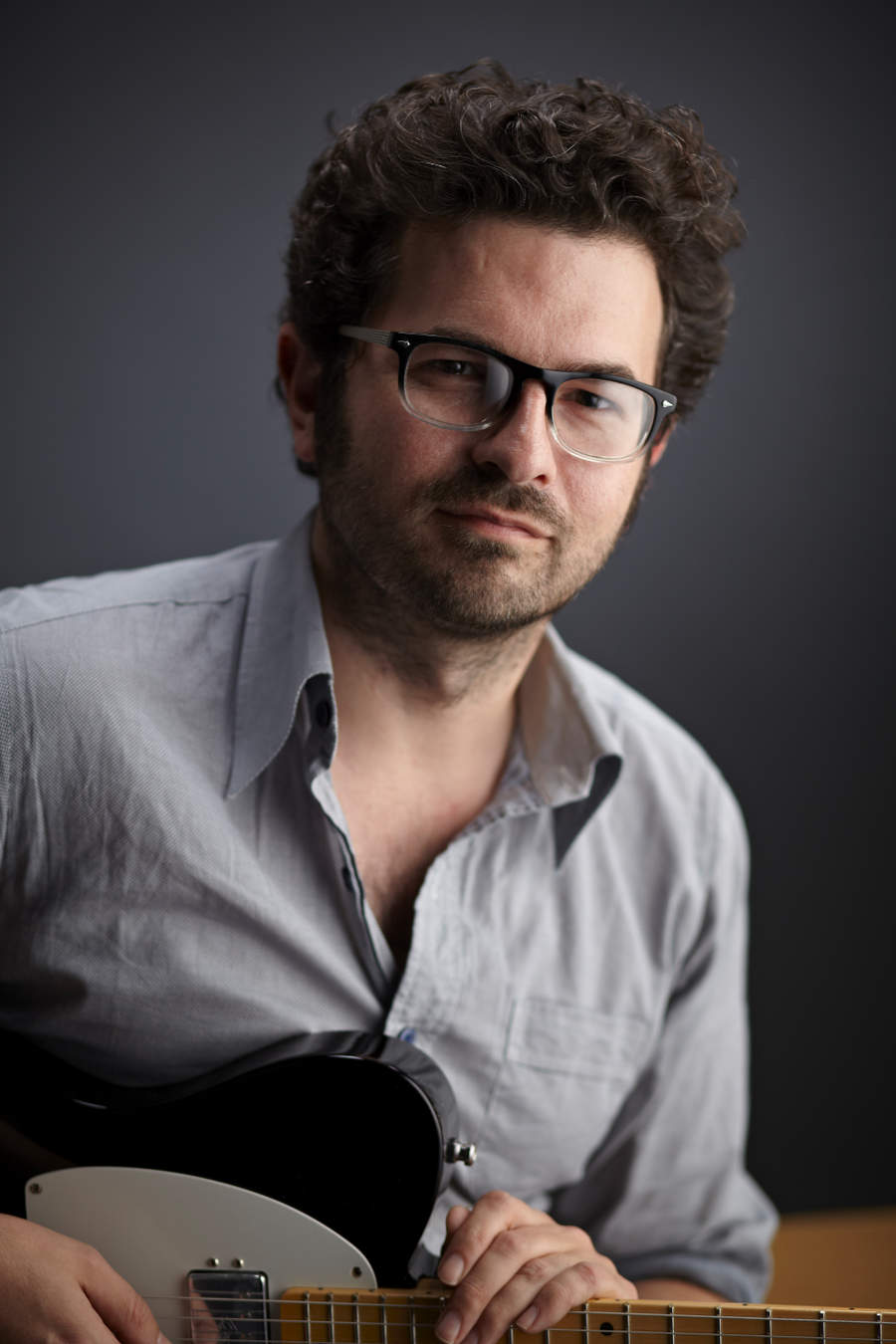
Jamie Dickson is Editor-in-Chief of Guitarist magazine, Britain's best-selling and longest-running monthly for guitar players. He started his career at the Daily Telegraph in London, where his first assignment was interviewing blue-eyed soul legend Robert Palmer, going on to become a full-time author on music, writing for benchmark references such as 1001 Albums You Must Hear Before You Die and Dorling Kindersley's How To Play Guitar Step By Step. He joined Guitarist in 2011 and since then it has been his privilege to interview everyone from B.B. King to St. Vincent for Guitarist's readers, while sharing insights into scores of historic guitars, from Rory Gallagher's '61 Strat to the first Martin D-28 ever made.

